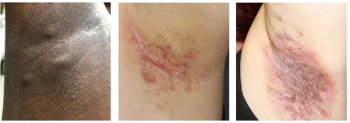
Positive Results from 2 Novartis Trials for HS Treatment
SUNSHINE and SUNRISE trials showed superior efficacy over the placebo.
A presentation of data from 2 pivotal phase III studies on secukinumab (Cosentyx: Novartis) for the treatment of moderate-to-severe hidradenitis suppurativa (HS) was delivered at the 31st Annual European Academy of Dermatology and Venereology Congress in Milan, Italy.1 The SUNNY program, containing both SUNRISE and SUNSHINE trials, is the largest phase III trial for HS and enrolled more than 1,000 patients across 33 countries.
Both trials, SUNSHINE and SUNRISE, contained positive results of the efficacy of secukinumab vs placebo with statistically significant improvement in HS signs and symptoms.2 Data from each trial will be submitted to the US Food and Drug Administration (FDA) in the US later this year and has already been submitted to European regulatory authorities. Secukinumab will offer a new treatment option to patients with HS to address the current gap in care. Novartis has also stated that they plan to release long-term results from each trial in 2023.
SUNRISE and SUNSHINE examined 2 secukinumab dose regimens over 16-week and 52-week treatment courses. Results showed a significantly higher percentage of patients achieved a Hidradenitis Suppurativa Clinical Response (HiSCR) when treated with 300 mg of secukinumab, administered every 2 weeks (after standard weekly loading doses), compared with placebo at week 16 in both trials (45.0% vs 33.7% [P=.0070] and 42.3% vs 31.2% [P=0.0149]). The primary endpoint of both trials assessed the achievement of (HiSCR) after 16 weeks of treatment.
"The recent announcement of the successful clinical trials for secukinumab in the treatment of hidradenitis suppurativa may provide an important therapueutic option for treatment of this debilitating disease, once FDA approved. Hidradenitis supperativa is a socially embarrassing disease that lowers patient self-esteem," said Zoe Diana Draelos, MD, consulting professor of dermatology in the department of dermatology at Duke University School of Medicine in Durham, North Carolina.
When administered every 4 weeks after standard weekly loading doses, 300 mg of secukinumab was superior to placebo for achieving HiSCR in the SUNRISE study (46.1% vs 31.2% [P=0.0022]), but it did not meet statistical significance in the SUNSHINE study (41.8% vs 33.7% [P=0.0418]).
HiSCR is defined as at least a 50% decrease in inflammatory lesion count of abscesses and inflammatory nodules, and no increase or draining fistulas when compared to baseline. The safety profile was consistent with that of secukinumab in existing indications, and no new safety signals were observed in either dosing group.
Key secondary endpoints included the percentage change from baseline in abscess and inflammatory nodule count at 16 weeks, the proportion of patients experiencing a flare over 16 weeks, and the proportion of patients with skin pain at week 16, measured using the Numeric Rating Scale 30 (NRS30) response. Many HS patients report skin pain as one of the most bothersome symptoms.
"Secukinumab has enjoyed an excellent safety and efficacy profile for many years in the treatment of psoriasis. Using this time tested biologic for hidradenitis supperativa will be an excellent addition to the dermatologic therapeutic armamentarium," said Draelos.
The SUNSHINE trial included 541 patients and the SUNRISE trial included 543 patients. Criteria for the trials included a diagnosis of HS at least 1 year prior to baseline, at least 5 inflammatory lesions, and the lesions should affect at least 2 distinct anatomic areas.
HS is a chronic inflammatory skin condition that causes small, painful bumps to form under the skin. The bumps typically form in areas where skin rubs together, such as the armpits, groin, buttocks, and breasts. The bumps are slow healing, recurring, and often lead to tunnels under the skin or scarring. Many of the bumps break open and result in painful abscesses. Currently, there is no cure for the debilitating disease.
References:
- Kimball AB, Alavi A, Jemec GBE, et al. Secukinumab in moderate to severe hidradenitis suppurativa: Primary endpoint analysis from the SUNSHINE and SUNRISE phase 3 trials. Presented at the 31st European Academy of Dermatology and Venereology Congress; September 7–10, 2022; Milan, Italy.
- Novartis Cosentyx shows clinically meaningful symptom improvements in patients with hidradenitis suppurativa in pivotal phase III trials. Novartis. Accessed September 13, 2022. https://www.novartis.com/news/media-releases/novartis-cosentyx-shows-clinically-meaningful-symptom-improvements-patients-hidradenitis-suppurativa-pivotal-phase-iii-trials
Newsletter
Like what you’re reading? Subscribe to Dermatology Times for weekly updates on therapies, innovations, and real-world practice tips.

















